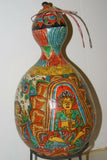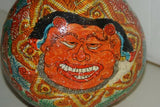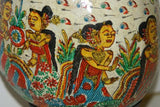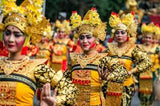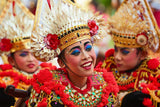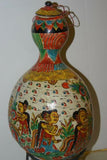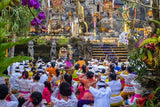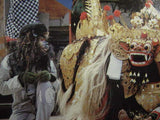Unique Large Balinese Lime Gourd Hand painted with Wayang Kulit traditional & detailed motifs, Beautiful Kamasan Art depicting Ramayana Epic Scenes: 1G2, 15” tall. Betel habit paraphernalia. Collected in late 1900’s
Balinese Lime Gourd, One of a kind, hand-painted with details in the tradition of Wayang Kulit Art, Typical Kamasan style, depicting a scene from the Ramayana Epics.
Item: 1G2.
Measures: 15" tall X 9" wide. Good Condition
This Traditional one of a kind vintage highly collectible Lime Gourd Container with lid was created to carry lime during festivals and temple processions.
Collected near the regency of Klungkung,
Hand-painted by a local Kamasan artist.
The Gourd designs represent shadow puppets or wayang kulit and scenes of the Ramayana tales and Mahabaratha epics as per the very old tradition of the Kamasan style, originated within the Java Royal courts of past centuries. It is painted all around, including the bottom which has a large red face to ward off evil.
A chronicle on Balinese history mentions that during the reign of his majesty king Dalem Watu Renggong (1460 to 1550 AD ), Bali controlled the East Javanese kingdom of Blambangan (now Banyuwangi Regency) where a box of wayang kulit figures (shadow puppets) was found, confiscated and brought back to the palace in Bali. Since the king loved arts and letters, historians suppose that he ordered one of his artists to develop a painting based on the puppet style. A village near the capital city of the kingdom named Kamasan became the place where the first painting of this style was developed. This style of painting today is often called the Kamasan or wayang style as a result, and it draws its main themes from Old Javanese literary classics such as the Ramayana and the Mahabaratha epics. In the service of the kings of Gelgel and Klungkung up until the beginning of this century, it was only natural that the painters and illustrators, called 'Sangging', should settle in this one area and it was not uncommon for ruling families from other parts of Bali to acquire the use of a Sangging to decorate their own palaces or temples, thus the Kamasan style of painting was born and the style quickly spread throughout the whole of Bali but to this day is still only painted in the small village of Kamasan where it originated. This style being very detailed is time consuming to create.
Betel is a mild stimulant chewed by about ten per cent of the world's population. The betel chew consists of the seed of the areca palm (the betel nut), the fruit or leaf of the betel pepper vine, and mineral lime. The lime is kept in a container and taken to the mouth with an implement. Depending on the region, the lime containers are made from gourds, bamboo, bone, carved wood and often have finely detailed stoppers. In and in general, shapes and materials used for the receptacles that will contain lime powder or betel differ from country to country. The receptacles, boxes and carry-cases for the lime powder are generally superbly carved with a great variety of human figures, animals, plants portraying important aspects of each culture and referring to the status of the owner.
All our collector and rare items come with pages and pages of research about provenance, and with history of the tribes and photos as well, depending on item and whenever possible. When shipping internationally, we group ship multiple purchases to save you money, and find the best rates available. If you have any questions or want to see research conducted on this piece, let us know.






















